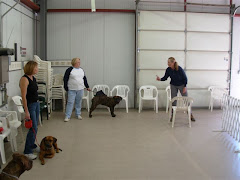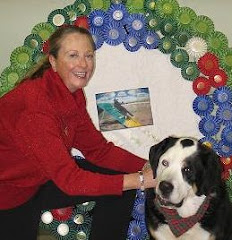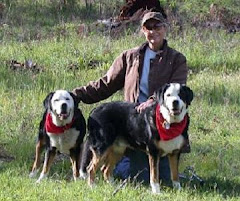
"Slow to sit."
This is a comment frequently seen on judges' scorecards in AKC obedience and rally trials. The dog and handler are penalized if the dog is slow to assume the "sit" position at the appropriate times during the judged obedience routine.
Even in a basic puppy obedience class, many trainers encourage dogs to slam their butts down on cue. Most people are impressed by a dog that does it. "Oh, look at that! He sits so fast! Isn't that cute!"
Not me. If I were an obedience judge, I'd want to give the "slow sitters" even higher scores than the robotically trained dogs that go through the routines with perfection. Sorry, but those border collies that "heel" with their heads cranked up toward their handlers, oblivious to the world around them, make my stomach queasy. I'd like to say "Shame on you, Handler!" for taking such a lovely, thinking, attuned dog as a border collie (just a for-instance) and turning it into a wind-up toy. It's phony, unnnatural, and does little to honor the wonderful and natural abilities of a thinking dog.
What I want to see is a dog who makes a deliberate choice to sit for his handler, even if he doesn't particularly feel like doing it. Now THAT is obedience!
Dogs may be "slow to sit" for any number of perfectly valid reasons, and they shouldn't be penalized for most of them. If your dog is a bit slow to respond to this simple command, here are some of the logical reasons:
1. You have a large dog. Just as it can be a major process for a large person to sit down in a chair, it's major for a large dog to get his body into the sit position. You shouldn't expect a big-butted St. Bernard to sit as fast as a toy poodle. It's physically not possible. A Doberman or Dane has a lot of leg to gather up first. Even a Labrador puppy should be allowed to take his time and get comfortable and balanced before his rear touches the floor.
2. You have a dog with some aches and pains. I'm not talking about unsoundness, just the minor day-to-day stiffness and hitches that we ALL occasionally (?) suffer. They have the same issues.
3. Your dog is an independent thinker. He knows the command, and ultimately he will do your bidding, but he also has a mind of his own. Give him an extra half-second to make the right choice. And reward him for it!!
4. Your dog is a slow thinker. He processes information at a slower rate than other dogs. It takes a few seconds for your commands to "sink in." That's okay! God bless him if he's not the brightest bulb in the box and he STILL makes an effort to do your bidding!
There's only one reason to penalize a dog with a "slow sit." And really, the handler should be penalized instead of the dog. The handler hasn't learned how to be a leader, how to command the dog's attention, how to make his or her leadership and direction THE MOST important thing in that dog's life. So this unfocused, inattentive dog is demonstrating that he simply doesn't care what his "leader" is telling him to do. Now that's serious, because it can also be life-threatening. An uncaring dog won't come back when called either, and is likely to get hit by a car or meet some other tragic end from being disobedient.
When I teach my beginning students to "sit" their dogs, I encourage true communication skills. First we spend a few days showing the dog what we want by helping him assume the sit position when we give the command. Once the dog has learned the command to sit, the ideal practice scenario goes like this:
The handler looks down at the dog standing beside her. "Gypsy?" she says. Gypsy looks up at her, as if you say, "Yes, Mommy?"
"Sit," the handler says.
Gypsy immediately begins to gather up her hindquarters and politely tucks her butt into a sit position. Gypsy looks up at the handler as if to say, "Is this what you want?"
The handler lovingly praises her dog's cooperation and compliance (not the sit) by saying "Good sit!"
Now that should be a high-scoring sit! It demonstrates:
1. The dog has true knowledge of what the command means.
2. The dog is attentive to the handler (leader).
3. The dog is making a deliberate decision to obey her handler.
It also demonstrates what our friend Cesar Millan calls "calm/submissive" energy in a dog. Remember, you the leader are "calm/assertive." The dog is "calm/submissive." Whatever directives you give your dog, look for this type of reaction at all times. If you don't see it, scrutinize your overall relationship with the dog. Look for ways to be a better leader, a better motivator. Inspire your dog to think and make choices, and take great pleasure in seeing your dog respond this way, rather than like a robot.
It warms my heart when I see a dog respond to its handler this way. Too bad "Heartwarming" isn't on the scoresheet in an obedience trial.


















No comments:
Post a Comment